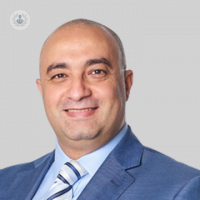Exploring ankle instability: part 1
Written by:Participating in sport can put a huge strain on our bodies, particularly on the ankles, leading to ankle instability. In the first article of a two-part series, renowned consultant orthopaedic surgeon Mr Hisham Shalaby discusses ankle stability, and what factors can contribute to its instability.

What is ankle stability, and why is it important for overall joint health?
The ankle joint is a very stable and congruent joint, that exhibits exceptional stability and congruence, primarily due to bony architecture, encompassing the shape of the bones and the way that the talus fits within the ankle mortis. This structural integrity establishes a foundation for remarkable joint stability.
Additionally, the ligaments play a pivotal role in maintaining stability. The ankle is surrounded by ligaments on the medial, or inside, and lateral, or the outside, aspects of, the joint. They are robust ligaments that contribute significantly to keeping the joint stable.
Positioned on both the medial (inside) and lateral (outside) aspects of the joint, these robust ligaments significantly contribute to upholding the joint's stability.
A third crucial factor involves dynamic stabilisers, which are the tendons surrounding the ankle joint. As these tendons connect muscles to bones, their strength directly enhances the overall stability of the joint. In essence, a combination of bony architecture, ligaments, and dynamic stabilisers work to ensure the ankle joint remains steadfast and secure.
In terms of why stability is important, stability holds significant importance for any joint, particularly for the ankle joint. Stability results in conformity of the joint surface, facilitating seamless movement and, consequently, reducing the likelihood of wear and tear in the joint.
When the joint is stable, the chances of sustaining another injury decrease. The most important aspect of joint stability is preventing cumulative damage to the joint. This raises the question: what are the main factors that can lead to ankle instability? Ankle instability typically occurs after an initial injury to the joint that has been managed. The most common injuries are sprains, when a person goes over their ankle or rolls their ankle. After a sprain, individuals usually experience pain, swelling, and bruising.
Depending on the severity of the ankle sprain, proper treatment is essential. For example, a significant injury resulting in soreness, swelling, and bruising requires appropriate treatment. Ideally, the patient should go to A&E or a minor injuries unit for assessment with x-rays to rule out fractures.
Subsequently, patients should undergo a period of rest or immobilisation in a boot. This allows the joint to rest, reduces swelling and pain, and prevents tightness of the calf muscles. Moreover, it facilitates the healing of ligament injuries. Following this, patients should engage in a rehabilitation program with a physiotherapist.
This is how ankle injuries should be initially managed. Poor management, such as inadequate immobilisation and lack of rehabilitation after a significant injury, can lead to joint instability and the joint giving way, accompanied by persistent pain. Pain usually occurs when tendons around the ankle overwork to compensate for the instability.
What are the main factors that can lead to ankle instability?
Ankle instability invariably occurs after an initial injury to the joint that has been managed. The most common injuries involve sprains, where individuals either go over their ankle or roll it, resulting in pain, swelling, and bruising. Proper treatment is crucial, especially for significant ankle sprains characterised by soreness, swelling, and bruising. Ideally, patients should seek assessment in A&E or a minor injuries unit with x-rays to rule out fractures.
Following assessment, patients should undergo a period of rest or immobilisation in a boot. This facilitates joint rest, reduces swelling and pain, and prevents tightness in the calf muscles. It also supports the healing of ligament injuries. Subsequently, patients should engage in a rehabilitation programme with a physiotherapist.
This comprehensive approach is essential for the initial management of ankle injuries. Poor management, such as insufficient immobilisation and a lack of physiotherapy rehabilitation after a significant injury, can lead to joint instability and persistent pain. The joint becomes prone to giving way when tendons compensate for instability, emphasising the importance of proper care for long-term ankle health.
If you are suffering from ankle instability and would like to book a consultation with Mr Shalaby, do not hesitate to do so by visiting his Top Doctors profile today


